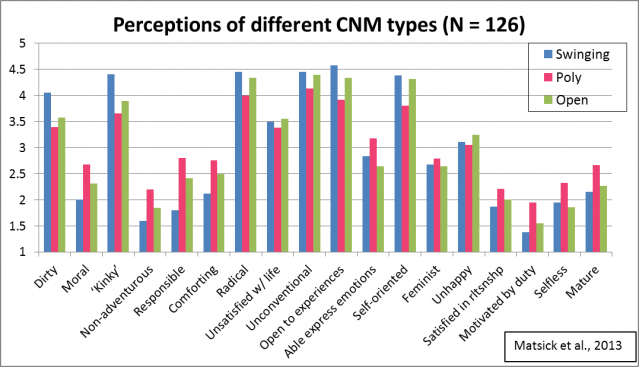Relationships
Who’s More Stigmatized: Swingers or Polyamorists?
Not all consensually nonmonogamous relationships were created equal.
Posted July 28, 2014

Last month, I reviewed the research on stigma against consensual nonmonogamy (CNM) compared to monogamy. At no one’s surprise, nonmonogamy was perceived—by monogamists as well as nonmonogamists—as inferior to monogamy on virtually every relevant and irrelevant personal, relational, and social characteristic. But all are types of CNM created equal, or are some forms more palatable to people than others? That is the question that the same research team that documented the stigma against nonmonogamy in general turned to next.
In a study published online ahead of print in Psychology & Sexuality in 2013, Jes Matsick, a PhD candidate at the University of Michigan, and her colleagues surveyed a large online sample of over 2,000 people recruited through classified ads and social network websites (read: Craigslist and Facebook). Because it’s really easy to find statistically significant results with such large samples, for this particular study, they randomly selected 5 percent of that sample, for a total of 126 participants (56 percent female, 73 percent undergrads, 79 percent heterosexual, 88 percent white) with a mean age of 25.
Participants were randomly assigned to read one of three definitions of a type of CNM relationship – all defined as relationships in which all partners understand that they are not monogamous.
Swinging. Couples who desire sexual relationships with people other than their primary partner and typically engage in these relationships at a party or in another social setting. A key component is that the primary couple views swinging as something that they do together as a couple. That is, swinging is viewed as a pastime for the couple. The relationships that occur outside of the relationship are only sexual and not romantic or emotional.
Polyamory. Couples who desire to have emotional, romantic, and sexual relationships with more than one person. A key component is the desire to have multiple relationships that are not just sexual, but also romantic/emotional.
Open relationship. Couples who desire to have sexual relationships with someone other than their primary partner. A key component is the desire to have multiple relationships that are only sexual, not romantic or emotional. Moreover, the individual members of the couple typically pursue relationships that occur outside of the primary relationship independently. For example, a member of the couple would meet with someone other than their primary partner without the primary partner present.
After reading the description, participants were asked to rate this particular type of CNM relationship on 18 different characteristics on a scale of 1 to 5. The graph below illustrates the results.

There were significant differences in 13 of the 18 characteristics, with polyamorous relationships often being perceived more favorably than both swinging and open relationships, and swinging often perceived least favorably of them all. For example, compared to swingers, poly people were perceived as significantly more moral, clean, mature, responsible, able to express emotions, and less self-oriented (i.e. more family-oriented); those in open relationships were often perceived as somewhere in between the two extremes.
If it’s any consolation to the swingers, they were perceived as more unconventional, adventurous, kinky, radical, and open to new experiences, although all three types were rated pretty high up there (well above the mid-point of the scale) on these characteristics signaling non-conformity and unconventionality.
And the few characteristics where there were no perceived differences among the three relationship types further strengthened the general negative view of CNM: All three types were perceived to be equally and generally unsatisfied in their relationship, unsatisfied with life, and unhappy.
That swingers (and to a lesser extent those in open relationships) are perceived more negatively and as greater social outliers than polyamorists may be puzzling at first, but there are at least two logical and likely explanations for this. Like polyamorists, swingers fly in the face of one of the most beloved, almost sacred, tenets of modern Western morals: monogamy. But unlike polyamorists, swingers defy yet another core belief: That sex should be an expression of love, not just lust. While our culture strongly embraces the former, it has yet to get comfortable with the latter. The fact that polyamory is more palatable than swinging suggests that, even among young and fairly liberal people like those in this sample, the stigma against sex without love is stronger than the stigma against loving more than one person at a time.
And, as both anecdotal and research evidence suggest, polyamorists themselves are not immune to this stigma – they often disparage swingers as leading shallow and inferior sexual and romantic lives.
Because of their focus on more casual, transient sexual adventures, swingers are also probably perceived as more promiscuous than polyamorists, and people may fear that they are therefore more likely to spread STIs. (Unfortunately, this study didn’t ask about perceptions of promiscuity or STI risk, so this currently remains only a hypothesis.)
As fascinating as this study is, I am left wondering where different CNM types stand in relation to other nonconventional sexualities, for example, gays, lesbians, bisexuals, transsexuals, BDSM practitioners, cheaters, highly promiscuous people, sex workers, clients of sex workers, etc. Who’s perceived as the worst? If you have a theory, I’d like to hear it in the comments.
Have a casual or group sex story to share with the world? Or want to read other people's hookup experiences? That's what The Casual Sex Project and @CasualSexProj are for.
Follow me on Twitter @DrZhana for daily updates on the latest in sex research, check out my website or my Facebook page for more information about me, or sign up for my monthly newsletter to stay up to date with all my sex research-related activities.
References:
Klesse, C. (2006). Polyamory and its ‘others’: Contesting the terms of non-monogamy. Sexualities, 9, 565–583. doi:10.1177/1363460706069986
Matsick, J. L., Conley, T. D., Ziegler, A., & Moors, A. C. (2013). Love and sex: polyamorous relationships are perceived more favourably than swinging and open relationships. Psychology & Sexuality, online ahead of print. doi:10.1080/19419899.2013.832934




